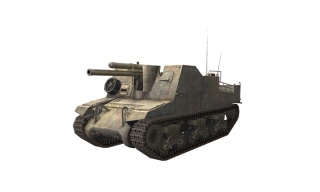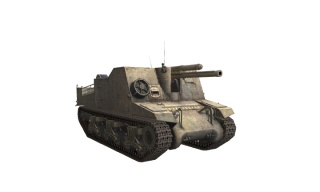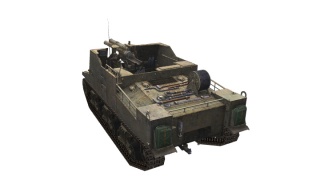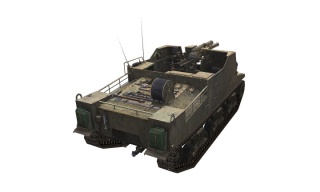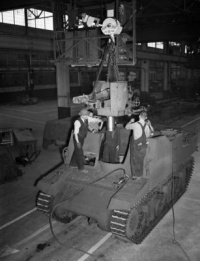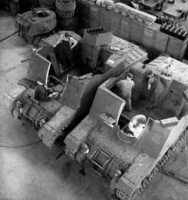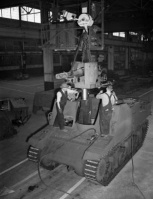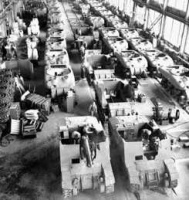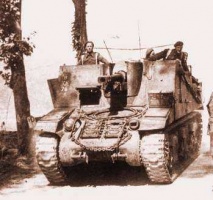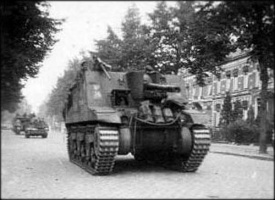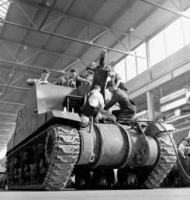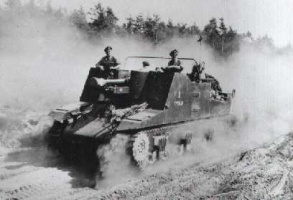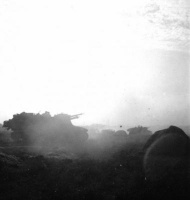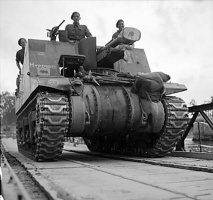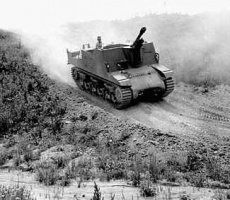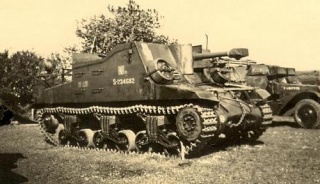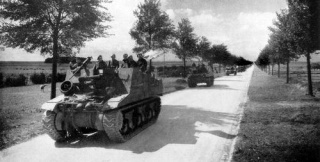Sexton II
Sexton II
Mouse over "
[Client Values; Actual values in
| 49,000 |
| 25050 HP Hit Points |
| 25.77/25.912.4/28 t Weight Limit |
- Commander
- Gunner
- Driver
- Radio Operator
- Loader
- Loader
| 400460 hp Engine Power |
| 40.2/10 km/h Speed Limit |
| 1820 deg/s Traverse |
| 15.5237.1 hp/t Power/Wt Ratio |
| YesYes Pivot |
| // mm Hull Armor |
HE
HE Shells |
72/0
83/0 Shell Cost |
| 260//280// HP Damage |
| 21//22// mm Penetration |
|
5.45 r/m ▲
5 r/m Standard Gun ▲ Rate of Fire Standard Gun |
|
1417 ▲
1400 Standard Gun ▲ Damage Per Minute Standard Gun |
|
0.78 m ▲
0.76 m With 50% Crew: 0.966 m ▲ Accuracy With 50% Crew: 0.941 m |
| 5.5 s 5.5 s Aim time |
| 1616 deg/s Gun Traverse Speed |
| 40° Gun Arc |
| -5°/+38°-9°/+40° Elevation Arc |
| 195195 rounds Ammo Capacity |
| 2020 % Chance of Fire |
| 260 m 260 m View Range |
| 400 m 550 m Signal Range |
III
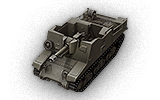
49000
The Sexton II is a British tier 3 self-propelled gun.
Modification of the Grizzly (M4A1 Sherman) tank, mounting the British 25-pounder field howitzer. Mass production was launched at the Montreal Locomotive Works in Canada, with 2,150 vehicles manufactured from 1943 through 1945.
The Sexton II marks the end of its British self-propelled gun line.
Modules / Available Equipment and Consumables
Modules
| Tier | Engine | Engine Power (hp) |
Chance of Fire on Impact (%) |
Weight (kg) |
Price (
| |
|---|---|---|---|---|---|---|
| IV | Wright Continental R-975C1 | 400 | 20 | 516 | 11580 | |
| V | Wright Continental R-975C4 | 460 | 20 | 550 | 13900 |
| Tier | Suspension | Load Limit (т) |
Traverse Speed (gr/sec) |
Rmin | Weight (kg) |
Price (
| |
|---|---|---|---|---|---|---|---|
| II | Sexton | 25.9 | 18 | 0 | 11000 | 600 | |
| III | Sexton II | 28 | 20 | 0 | 11000 | 1900 |
| Tier | Radio | Signal Range (m) |
Weight (kg) |
Price (
| |
|---|---|---|---|---|---|
| VII | WS No. 19 Mk. II | 450 | 40 | 21000 | |
| VI | WS No. 19 Mk. I | 400 | 40 | 15000 | |
| VIII | WS No. 19 Mk. III | 550 | 40 | 22000 |
Compatible Equipment
Compatible Consumables
Player Opinion
Pros and Cons
Pros:
- Gun range: stock: 850 m, top: 1050 m
- Excellent RoF
- Good gun sweep
- Good straight-line speed
- Decent accuracy
Cons:
- Low Alpha damage
- Worst penetration of all Tier III SPGs
- Slow track traverse - it is awful
- Low shell arc
- Somewhat large target
Performance
The Sexton II is similar in performance to the M7 Priest ,although while the Priest has a slower firing, more inaccurate gun with huge damage, the Sexton II has a fast-firing gun with underwhelming damage and penetration. Despite this, it's not a bad SPG, as the high rate of fire, decent accuracy and huge ammo capacity enable you to dish out shells in a steady rate. The mobility is very similar to the Priest with good straight-line speed and lots of horsepower, although any kind of attempted turning will slow you down greatly. The traverse rate is poor, but once you get up to speed you can outrun many would-be assailants. The decent armor and health allow you to survive a little longer than some other SPGs against enemy fire, but are still nothing to rely upon, as you will go up in flames if anything with decent damage output comes your way. Against autocannon-toting scouts, however, your good gun depression coupled with the decent durability of your armor will allow you to take potshots at them from point-blank range if one gets too close for comfort. However, don't expect to survive anyone who fires at your superstructure, as it can be penetrated even by the weakest High-Explosive shells. Your traverse rate is poor, however, so any scout that gets close enough will have no trouble literally running circles around you, and the low damage and penetration mean that the scout doesn't necessarily die if you hit it. You may have to move up to 100-200 meters from your deployment point on large maps due to the unexceptional shell range, at least if attempting to fire from corner to corner.
Mine has a bumper sticker "I would rather be in the M7 Priest"
Early Research
- Nothing carries over from the Loyd Gun Carriage.
- First, research the Q.F. 25-Pr. Gun/How.
- Next, research the Wright Continental R-975C4 Engine.
- Research the WS No. 19 Mk. II Radio, followed by the WS No. 19 Mk. III Radio.
- Finally, research the Sexton II Suspension.
Suggested Equipment
Gallery
Historical Info
The 25pdr SP, tracked, Sexton was a self-propelled artillery vehicle of World War II, based on an American tank hull design, built by Canada for the British Army, and associated Commonwealth forces, and some of the other Allies. It was developed to give the British Army a mobile artillery gun using their Ordnance QF 25 ponder gun-howitzer. From 1943 it replaced the US built M7 Priest (US 105 mm guns on a M3 Lee tank chassis); these had replaced the British Bishop (25 pdr on Valentine tank chassis) which had been improvised in 1942.
Development history
In 1942, the US supplied enough M7 Priest self-propelled howitzers to equip a number of British Army artillery units in fighting in North Africa. The British found the Priest to be an excellent weapon, which gave artillery the same mobility as tank units. However, the Priest used the American 105 mm howitzer rather than the British equivalent, the QF 25 ponder gun-howitzer. Having to supply different ammunition for a few units complicated supply for the British Army. The US attempted to fit a 25 ponder to the M7 Priest - producing the T51 in mid 1942 - but the program suffered delays including the destruction of the gun mount on the prototype during the first live-firing exercises. US resources were not available for a vehicle solely for British use so Britain turned to Canada. The Canadian Army Engineering Design Branch through the Canadian government's Department of Munitions and Supply were asked to build a vehicle similar to the M7 on the Ram tank chassis. The Ram tank was a Canadian tank design that used the chassis of the American Medium Tank M3 as did the Priest. The Ram had been sidelined by a decision to standardize on the Sherman tank for British and Canadian units. A prototype was completed on 23 June 1942. Following trials in Canada, the Canadian government ordered 124 vehicles in three batches. The prototype was shipped to the United Kingdom in early 1943, where it underwent further trials; the vehicle was found to be highly satisfactory and was given the designation "Sexton" (after the religious custodian) in May 1943. The British government ordered 300 Sextons in the summer of 1943; however, these Sextons were to be built on Grizzly tank hulls (Canadian-built M4A1 Sherman tanks) instead of Ram tank hulls. The Ram-based Sexton was designated as the Sexton Mark I and the Grizzly-based Sexton was designated the Sexton Mark II. British orders for the Sexton II eventually totaled 2,026 vehicles.
Unlike the Ram, which was inferior operationally to the Sherman and never saw combat as a gun tank, the Sexton was successful. Between 1943 and 1945, the Montreal Locomotive Works manufactured a total of 2,150 Sextons for the use of both Canadian and British forces. The vehicle entered service in September 1943. The vehicles were first used in combat in Italy by the British Eighth Army. Later Sextons took part in the invasion of France and subsequent Battle of Normandy and the campaign in north-western Europe. During the D-day landings a number of Sextons were ordered to fire from their landing craft as they approached the beaches although the fire did not prove to be very accurate. In spite of its confused origins, the Sexton was a combination of proven parts and proved to be a successful design and remained in British service until 1956. In oppose to Germany, which often used its self-propelled guns (assault guns) in a front line direct fire role, Britain and Canada only used the Sexton for indirect supporting fire. They kept the Sextons well back from the front line and used forward observers to direct overwhelming fire on a target.
Historical Gallery
Historical Accuracy Errata
The QF 18-pdr was only fitted to the Birch Gun. Its configuration on the Sexton is fake.
- The Birch Gun predates the Sexton by 20 years. In World of Tanks, however, the Birch Gun is the successor to the Sexton.
- The Sexton replaced the problematic Bishop in service. In World of Tanks, however, the Bishop is two tiers higher than the Sexton.
- Allied recognition star is missing.
| USA | IIT1 HMC • IIIT18 HMC • IIIM7 Priest • IVT82 HMC • IVM37 • VM41 HMC • VIM44 • VIIM12 • VIIIM40/M43 • IXM53/M55 • XT92 HMC |
| UK | IILoyd Gun Carriage • IIISexton II • IIISexton I • IVBirch Gun • VBishop • VIFV304 • VIICrusader 5.5-in. SP • VIIIFV207 • IXFV3805 • XConqueror Gun Carriage |
| Germany | IIG.Pz. Mk. VI (e) • IIISturmpanzer I Bison • IIIWespe • IVPz.Sfl. IVb • IVSturmpanzer II • VGrille • VIHummel • VIIG.W. Panther • VIIIG.W. Tiger (P) • IXG.W. Tiger • XG.W. E 100 |
| France | IIRenault FT 75 BS • IIILorraine 39L AM • IVAMX 105 AM mle. 47 • VAMX 13 105 AM mle. 50 • V105 leFH18B2 • VIAMX 13 F3 AM • VIILorraine 155 mle. 50 • VIIILorraine 155 mle. 51 • IXBat.-Châtillon 155 55 • XBat.-Châtillon 155 58 |
| USSR | IISU-18 • IIISU-26 • IVSU-5 • VSU-122A • VISU-8 • VIIS-51 • VIISU-14-1 • VIIISU-14-2 • IX212A • XObject 261 |
| China | |
| Japan | |
| Czechoslovakia | |
| Sweden | |
| Italy | |
| Poland |










